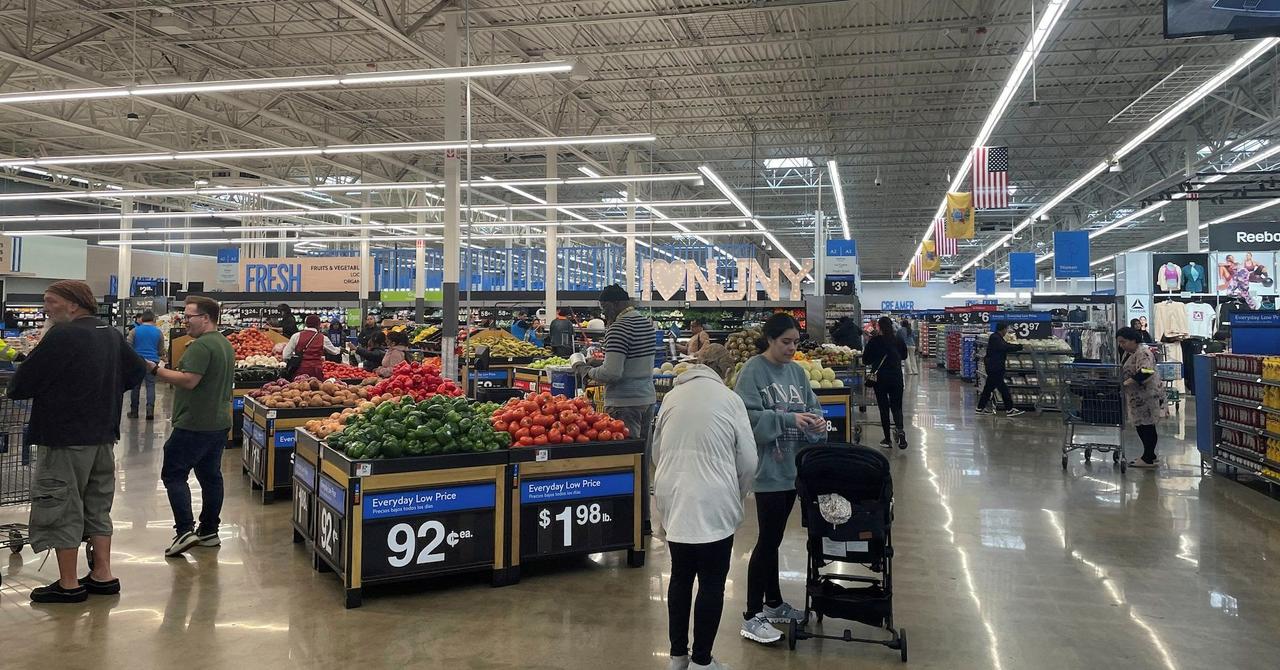Walmart Explores $200 Million Investment in Autonomous Forklifts to Enhance Warehouse Automation
3 Sources
3 Sources
[1]
Walmart Considers $200M Bet On Self-Driving Forklifts To Boost Automation - Walmart (NYSE:WMT)
Walmart considers $200 million for self-driving forklifts.Automation to add $20 billion profit by 2029. Walmart Inc WMT is likely to invest $200 million in self-driving forklifts to automate more of its warehouse operations. The world's largest retailer plans to buy potentially hundreds of autonomous forklifts from Fox Robotics, with whom it has already invested $25 million, reported Reuters citing sources. This move is part of Walmart's broader strategy to increase automation and compete with Amazon.com Inc AMZN. Walmart's plan includes exclusive deals with robotics vendors like Fox Robotics and Symbotic Inc SYM. These agreements will also restrict Walmart's competitors from using the technology. Walmart spokesperson Camille Dunn confirmed that the company is piloting the technology with 19 FoxBots in four facilities. Also Read: How Walmart Is Planning To Boost Perishables Distribution? Read To Know In recent years, Walmart has focused on robotics to manage costs and keep product prices low. Analysts from Jefferies estimate that Walmart could add $20 billion to its profit before interest and taxes by fiscal 2029 due to automation and AI efforts. Walmart's deal with Symbotic, announced in 2022, involves implementing automation in 42 distribution centers, where Walmart owns more than 13% of Symbotic stock. FoxBots, tested for over a year, can unload pallets and integrate them into Symbotic's automated system. Fox Robotics claims a single operator can manage up to six autonomous forklifts, reducing labor costs by 40%. Walmart stock has gained more than 29% in the last 12 months. Investors can gain access to the stock via the Consumer Staples Select Sector SPDR Fund XLP and Vanguard Consumer Staples ETF VDC. Price Action: WMT shares are trading lower by 0.91% at $69.38 at last check Friday. Read Next: Amazon To Surpass Walmart This Year As Largest US Retailer: Analyst Disclaimer: This content was partially produced with the help of AI tools and was reviewed and published by Benzinga editors. Market News and Data brought to you by Benzinga APIs
[2]
Walmart looks to bet $200 mln on autonomous forklifts -sources
NEW YORK, July 26 (Reuters) - Walmart has plans to potentially spend $200 million on self-driving forklifts as part of broader efforts to automate more warehouse operations, according to three people familiar with the matter. The world's largest retailer wants autonomous forklifts to move pallets of goods in its distribution centers, which replenish Walmart stores. It has intended to buy possibly hundreds from Fox Robotics and invested $25 million in the Austin-based startup, the sources said. The rollout, which Walmart could stop at any time, would occur in stages over several years and hinges on the retailer's satisfaction with the "FoxBots," said the people, who were not authorized to discuss the plans publicly. Details about Walmart's investment and rollout have not been reported before. They underscore the company's strategy for warehouse automation, which aims to grow profit and help it compete with retailers like Amazon.com. Camille Dunn, a Walmart spokesperson, declined to comment on the $200 million spending plans. She referred Reuters to an April announcement that said Walmart had piloted the technology and would add at least 19 FoxBots to four facilities, noting that deployments are "an evolving process" from proof of concept to rollout. "We evaluate the performance at each phase to determine if the technology meets our ability to better serve customers," she said in an email. "Some initiatives we scale, some initiatives we don't." Fox Robotics said its customer deals are confidential. In recent years, Walmart has focused increasingly on robotics to help it replenish stores, manage costs and keep the price of goods low. Analysts from Jefferies estimated the company could add $20 billion to its profit before interest and taxes by fiscal 2029, thanks to its efforts in automation and artificial intelligence. Arun Sundaram of CFRA Research added: "Expect more and larger deals in the future." As one example, Walmart announced a deal in 2022 with the robotics vendor Symbotic to implement automation in 42 distribution centers. Walmart owned more than 13% of Symbotic stock as of a January securities filing. Now, Walmart has taken a stake in Fox Robotics and has warrants to invest more, the people familiar with the matter told Reuters. The Fox and Symbotic deals are similar in that they restrict use of their technology by Walmart's biggest competitors, the sources said. Exclusive deals with suppliers are not uncommon in retail. The Symbotic agreement states that key employees would be bound by non-competes and receive competitive pay, while Symbotic would be barred from selling its technology in certain non-Walmart warehouses. Details were redacted in a securities filing. Walmart declined to comment on its contractual agreements with the robotics vendors. Symbotic said it does not comment on its customers' business strategies. STEMMING TURNOVER Tested for more than a year, the FoxBots unload pallets and help put them into Symbotic's automated system, which catalogs and stores goods, Walmart has said in press releases. A single human operator can manage up to six of the autonomous forklifts at a time, saving as much as 40% on labor costs, Fox Robotics said on its website. A worker is still needed to open warehouse doors for instance, but the goal is for Walmart to depend less on labor in the long run, the sources said. Dunn said, "People will always be part of our warehouse operations." Finding workers to staff warehouse and other blue-collar jobs can be challenging, two of the sources said. Employers might pay little for onerous work, and sometimes staffers do not show up, one of them said. "There's a younger generation of people that just don't want to do these jobs," the source said. At Walmart, a freight handler at its Coldwater, Michigan distribution center might "lift up to 40 to 60 pounds repetitively for extended periods of time," according to a job posting on Glassdoor. Another ad asked if a candidate had proficiency in operating equipment such as a forklift and would work 12-hour or overnight shifts, for $19.30 to $24.80 an hour. For David Guggina, executive vice president of supply chain operations at Walmart U.S., automation has meant new technical roles for associates and other employment opportunities, not job cuts. It reduces physically demanding work, giving Walmart "substantially low turnover," he said. "A reduction in turnover absolutely drives savings," Guggina told Reuters. "You improve your productivity because you have less folks that are sitting in what I call (the) learning curve." Asked how much Walmart was spending on automation overall, Guggina said Walmart was investing billions of dollars into its supply chain network. In spite of their promise, robotics have not always paid off for the company, which pulled the plug on shelf-scanning units in its stores years ago. Their long-term feasibility can be uncertain, depending on significant adjustments and a controlled environment, whereas humans can adapt faster, said Katie Driggs-Campbell, a professor the University of Illinois' Grainger College of Engineering. "We are still far away from the robotics replacing humans in the retail industry," she said. (Reporting by Siddharth Cavale in New York and Jeffrey Dastin in San Francisco; Editing by Richard Chang and Christopher Cushing and Miral Fahmy)
[3]
Exclusive-Walmart Looks to Bet $200 Million on Autonomous Forklifts -Sources
NEW YORK (Reuters) - Walmart has plans to potentially spend $200 million on self-driving forklifts as part of broader efforts to automate more warehouse operations, according to three people familiar with the matter. The world's largest retailer wants autonomous forklifts to move pallets of goods in its distribution centers, which replenish Walmart stores. It has intended to buy possibly hundreds from Fox Robotics and invested $25 million in the Austin-based startup, the sources said. The rollout, which Walmart could stop at any time, would occur in stages over several years and hinges on the retailer's satisfaction with the "FoxBots," said the people, who were not authorized to discuss the plans publicly. Details about Walmart's investment and rollout have not been reported before. They underscore the company's strategy for warehouse automation, which aims to grow profit and help it compete with retailers like Amazon.com. Camille Dunn, a Walmart spokesperson, declined to comment on the $200 million spending plans. She referred Reuters to an April announcement that said Walmart had piloted the technology and would add at least 19 FoxBots to four facilities, noting that deployments are "an evolving process" from proof of concept to rollout. "We evaluate the performance at each phase to determine if the technology meets our ability to better serve customers," she said in an email. "Some initiatives we scale, some initiatives we don't." Fox Robotics said its customer deals are confidential. In recent years, Walmart has focused increasingly on robotics to help it replenish stores, manage costs and keep the price of goods low. Analysts from Jefferies estimated the company could add $20 billion to its profit before interest and taxes by fiscal 2029, thanks to its efforts in automation and artificial intelligence. Arun Sundaram of CFRA Research added: "Expect more and larger deals in the future." As one example, Walmart announced a deal in 2022 with the robotics vendor Symbotic to implement automation in 42 distribution centers. Walmart owned more than 13% of Symbotic stock as of a January securities filing. Now, Walmart has taken a stake in Fox Robotics and has warrants to invest more, the people familiar with the matter told Reuters. The Fox and Symbotic deals are similar in that they restrict use of their technology by Walmart's biggest competitors, the sources said. Exclusive deals with suppliers are not uncommon in retail. The Symbotic agreement states that key employees would be bound by non-competes and receive competitive pay, while Symbotic would be barred from selling its technology in certain non-Walmart warehouses. Details were redacted in a securities filing. Walmart declined to comment on its contractual agreements with the robotics vendors. Symbotic said it does not comment on its customers' business strategies. STEMMING TURNOVER Tested for more than a year, the FoxBots unload pallets and help put them into Symbotic's automated system, which catalogues and stores goods, Walmart has said in press releases. A single human operator can manage up to six of the autonomous forklifts at a time, saving as much as 40% on labor costs, Fox Robotics said on its website. A worker is still needed to open warehouse doors for instance, but the goal is for Walmart to depend less on labor in the long run, the sources said. Dunn said, "People will always be part of our warehouse operations." Finding workers to staff warehouse and other blue-collar jobs can be challenging, two of the sources said. Employers might pay little for onerous work, and sometimes staffers do not show up, one of them said. "There's a younger generation of people that just don't want to do these jobs," the source said. At Walmart, a freight handler at its Coldwater, Michigan distribution center might "lift up to 40 to 60 pounds repetitively for extended periods of time," according to a job posting on Glassdoor. Another ad asked if a candidate had proficiency in operating equipment such as a forklift and would work 12-hour or overnight shifts, for $19.30 to $24.80 an hour. For David Guggina, executive vice president of supply chain operations at Walmart U.S., automation has meant new technical roles for associates and other employment opportunities, not job cuts. It reduces physically demanding work, giving Walmart "substantially low turnover," he said. "A reduction in turnover absolutely drives savings," Guggina told Reuters. "You improve your productivity because you have less folks that are sitting in what I call (the) learning curve." Asked how much Walmart was spending on automation overall, Guggina said Walmart was investing billions of dollars into its supply chain network. In spite of their promise, robotics have not always paid off for the company, which pulled the plug on shelf-scanning units in its stores years ago. Their long-term feasibility can be uncertain, depending on significant adjustments and a controlled environment, whereas humans can adapt faster, said Katie Driggs-Campbell, a professor the University of Illinois' Grainger College of Engineering. "We are still far away from the robotics replacing humans in the retail industry," she said. (Reporting by Siddharth Cavale in New York and Jeffrey Dastin in San Francisco; Editing by Richard Chang and Christopher Cushing and Miral Fahmy)
Share
Share
Copy Link
Walmart is considering a significant investment in self-driving forklifts to boost automation in its warehouses. The retail giant aims to improve efficiency and address labor shortages with this technological advancement.

Walmart's Ambitious Automation Plan
Retail giant Walmart is reportedly considering a substantial investment of approximately $200 million in autonomous forklifts to enhance automation in its warehouses
1
. This move comes as part of the company's ongoing efforts to improve efficiency and address labor shortages in its extensive network of distribution centers.The Technology Behind the Investment
The autonomous forklifts under consideration are produced by Symbotic, a company specializing in AI-powered robotics solutions for supply chains
2
. These self-driving vehicles are designed to navigate warehouse floors independently, moving pallets and other large items without human intervention. The technology utilizes advanced sensors and artificial intelligence to ensure safe and efficient operations within the complex warehouse environment.Potential Impact on Walmart's Operations
If implemented, this investment could significantly transform Walmart's warehouse operations. The autonomous forklifts are expected to operate around the clock, potentially increasing productivity and reducing operational costs
3
. This automation initiative aligns with Walmart's broader strategy to leverage technology in streamlining its supply chain and enhancing overall operational efficiency.Addressing Labor Challenges
One of the key drivers behind this potential investment is the ongoing labor shortage in the warehousing sector. By introducing autonomous forklifts, Walmart aims to mitigate the challenges associated with recruiting and retaining warehouse workers
1
. This technology could help the company maintain consistent operations even in tight labor markets, ensuring smooth functioning of its critical supply chain infrastructure.Related Stories
Walmart's Ongoing Automation Efforts
This consideration of autonomous forklifts is not an isolated initiative but part of Walmart's broader automation strategy. The company has already been working with Symbotic to implement AI-powered robotics systems in its regional distribution centers
2
. This existing partnership and Walmart's familiarity with Symbotic's technology likely influenced the decision to explore this significant investment in autonomous forklifts.Industry Implications and Future Outlook
Walmart's potential move towards autonomous forklifts could set a precedent in the retail industry, potentially encouraging other major players to explore similar technologies
3
. As the largest private employer in the United States, Walmart's decisions often have far-reaching implications for the broader retail and logistics sectors. This investment, if realized, could signal a shift towards more automated warehouse operations across the industry, reshaping the future of retail logistics and supply chain management.References
Summarized by
Navi
[1]
[2]
Related Stories
Symbotic Acquires Walmart's Robotics Unit in $200M Deal, Expanding AI-Driven Automation Partnership
16 Jan 2025•Business and Economy

Walmart Accelerates Automation with Sensor Technology and Drone Delivery
03 Oct 2025•Business and Economy

Walmart's AI Super Agents and Digital Twins Revolutionize Retail Operations
30 Aug 2025•Technology

Recent Highlights
1
Google launches Gemini 3 Flash as default AI model, delivering speed with Pro-grade reasoning
Technology

2
OpenAI launches GPT Image 1.5 as AI image generator war with Google intensifies
Technology

3
OpenAI launches ChatGPT app store, opening doors for third-party developers to build AI-powered apps
Technology





